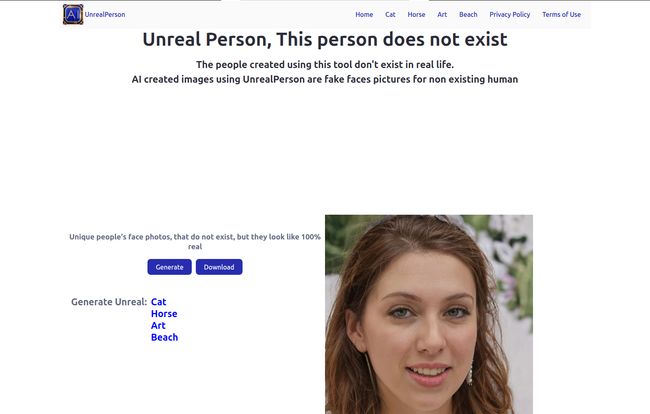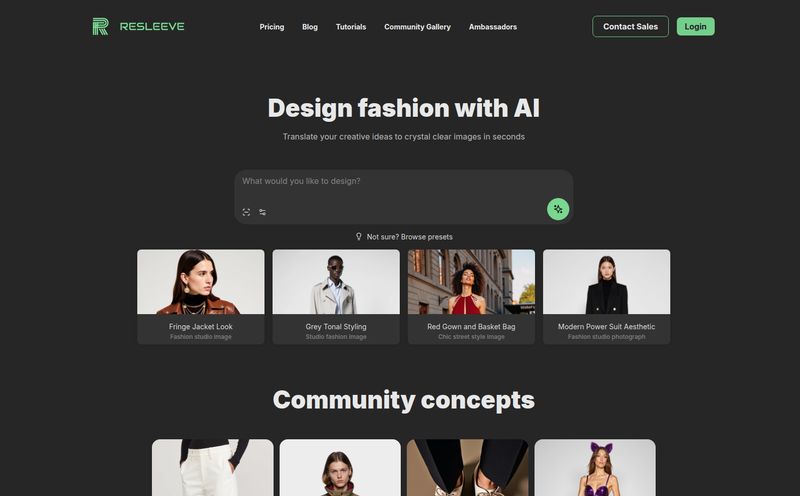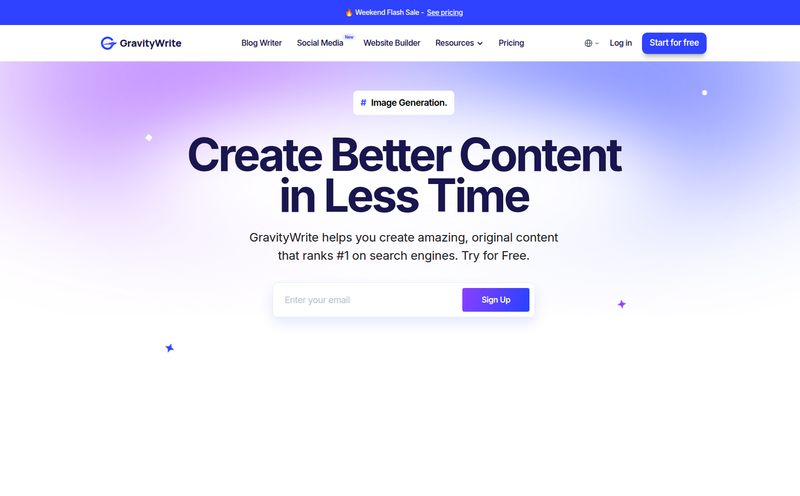I have. And I’m not talking about ghosts. I’m talking about AI. We’ve all been there, right? You’re scrolling through a site, maybe looking for a stock photo for a client presentation, and you're just... bored. The same smiling, lifeless models, the same perfect lighting. It’s the visual equivalent of hold music.
For years, finding the right face for a project—a user persona, a website testimonial, a character mock-up—was a chore. You either paid a premium for stock photos or risked using something generic that screamed “I downloaded this for free.” Then, a few years back, the internet started whispering about something wild: websites that could generate a human face out of thin air. A face of someone who does not exist.
Enter UnrealPerson. It's one of the latest players in this strange new world, and I’ve been kicking its tires. The premise is simple, almost comically so: it’s a free AI tool that generates images of fake people. And cats. And horses. And art. It’s a fascinating, slightly unsettling, and incredibly useful little corner of the web. Let's get into it.
So, What Is UnrealPerson, Really?
At its core, UnrealPerson is an AI image generator. It doesn’t pull from a database of existing photos. Instead, it creates entirely new, unique images every time you click the button. The site mentions it’s powered by some of the big guns in the AI world, like DALL-E 2.0 and Stable Diffusion, which is pretty impressive for a free tool.
It’s built on a technology called a generative adversarial network, or GAN. I’ll spare you the full computer science lecture, but the simple version is pretty cool. Think of it as an eternal competition between two AIs: a Forger and a Detective.
- The Forger AI creates a fake image (a face, in this case).
- The Detective AI looks at the fake and tries to determine if it’s real or not.
Every time the Detective catches a fake, the Forger learns and gets better. This process repeats millions of times, until the Forger gets so good that its creations are indistinguishable from reality. The results are the eerily realistic faces you see on the site. Pretty wild, huh?

Visit Unreal Person
My First Trip Down the AI Rabbit Hole
When I first landed on the UnrealPerson homepage, I was struck by its simplicity. There's no complex dashboard, no overwhelming menus. Just a picture of a woman who looks... real. And two big buttons: “Generate” and “Download.”
So, I clicked. Generate.
Instantly, a new face appeared. A middle-aged man with kind eyes and a slightly lopsided smile. He looked like someone’s uncle, the one who tells bad jokes at Thanksgiving. I clicked again. A young woman with freckles and a thoughtful expression. Again. An older gentleman who looked like a retired professor. It's addictive.
Each face is a story. You start inventing a life for them. That’s the magic, but also the weirdness. These people feel familiar, but they’re just collections of pixels, ghosts in teh machine. Sometimes you spot a glitch—a strangely formed earring, a nonsensical background, an extra tooth—that reminds you it's not real. But most of the time? They’re scarily convincing.
The Good, The Bad, and The AI-Generated
No tool is perfect, especially one that ventures into such new territory. After playing around for a while, I’ve got some strong feelings.
The Upsides are Pretty Obvious
First and foremost, it’s free. In an industry where every decent tool seems to have a subscription plan, a genuinely free and useful service is a breath of fresh air. The site says they plan to keep it free forever, which is a bold claim. I'm a bit cynical, but I'll take it for now! The ease of use is another huge win. You don’t need a tutorial or a degree in prompt engineering. You just click. This makes it accessible to everyone, from a marketing pro building a customer profile to a novelist who just wants to picture their protagonist.
And it's not just people! The ability to generate cats, horses, and abstract art is a fantastic bonus. Need a quick, copyright-free image for a blog post about pet care? Done. An artistic background for a slide deck? No problem. It's a surprisingly versatile little tool.
Let's Talk About the Downsides and the Ethical Mire
Okay, let’s address the elephant in the room. The potential for misuse is... significant. The site itself warns against using the faces for illegal activities like creating fake IDs or catfishing. And they're right to. In the wrong hands, a limitless supply of realistic, non-attributable faces is a powerful tool for deception. It's a classic case of technology outpacing our ethical frameworks.
There's also the question of resemblance. While the AI creates a new person, it’s trained on a dataset of real people. What happens when it generates a face that looks uncannily like your cousin, or a C-list celebrity? The legalities there are murky, to say the least. It’s something to be aware of if you’re using these images for any major commercial project.
Who Is This For, Anyway?
So, who is the ideal user for UnrealPerson?
In my opinion, it’s a fantastic resource for creatives and professionals in the digital space. Marketers can create detailed buyer personas without using cheesy stock photos. Web developers can populate user profile sections during testing. Authors and game designers can find inspiration for their characters. It's a tool for mock-ups, placeholders, and inspiration.
Who shouldn’t use it? Anyone looking to deceive, defraud, or create fake online identities to harass others. It’s about ethical use. Just because you can generate a fake profile for a social network doesn't mean you should. Use your powers for good people.
The Price is Right (Because There Isn't One)
I have to mention this again because it’s such a major point. UnrealPerson is 100% free. There's no pricing page, no credit system, no “free trial” that suddenly asks for your credit card. The value you get for a price tag of zero is, frankly, astounding. It democratizes a piece of AI technology that was, until recently, only accessible to those with serious technical skills or deep pockets.
A Final Thought on Our AI-Generated Future
Tools like UnrealPerson are more than just a novelty. They represent a fundamental shift in how we create and consume digital content. Is this the beginning of the end for the traditional stock photography industry? Maybe. At the very least, it's a massive disruption.
It’s a powerful, fascinating, and slightly scary tool. It offers a glimpse into a future where the line between what’s real and what’s artificially generated becomes increasingly blurred. My advice? Go check it out. Click the generate button a few times. But as you stare into the eyes of these people who never were, take a moment to think about the implications. It’s a brave new world out there.
Frequently Asked Questions
- What is UnrealPerson?
- UnrealPerson is a free online tool that uses Artificial Intelligence (AI), specifically a Generative Adversarial Network (GAN), to create unique, realistic images of people, cats, horses, and art that do not actually exist.
- Is UnrealPerson actually free to use?
- Yes, as of now, the tool is completely free. The website states their plan is to keep it free forever, with no hidden fees or subscriptions.
- Are the images from UnrealPerson safe to use for my projects?
- For most uses like mock-ups, personal projects, or creating personas, they are generally fine. However, since the AI is trained on real images, there's a small chance a generated face could resemble a real person. For major commercial campaigns, exercising caution or consulting legal advice is always a good idea. Never use them for illegal or deceptive purposes.
- Can I customize the person I want to generate?
- The information on the site suggests that customization by age and gender is a feature. However, the current user interface is very simple and primarily offers a random “Generate” button. This feature might be in development or available through a different interface not immediately obvious on the main page.
- What are the main risks of using AI-generated faces?
- The primary risks are ethical and social. These images can be misused to create fake social media profiles for scams, catfishing, spreading misinformation, or online harassment. It's crucial to use the technology responsibly.


